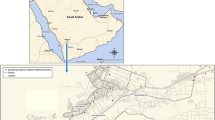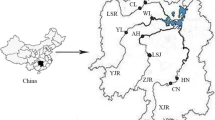Abstract
The levels of seven essential trace elements (Mn, Co, Ni, Cu, Zn, Se, and Mo) and six non-essential trace elements (Cr, As, Cd, Sb, Hg, and Pb) in a total of 89 drinking water samples collected in Shenzhen, China were determined using inductively coupled plasma mass spectrometry (ICP-MS) in the present study. Both the essential and non-essential trace elements were frequently detectable in the different kinds of drinking waters assessed. Remarkable temporal and spatial variations were observed among most of the trace elements in the tap water collected from two tap water treatment plants. Meanwhile, potential human health risk from these non-essential trace elements in the drinking water for local residents was also assessed. The median values of cancer risks associated with exposure to carcinogenic metals via drinking water consumption were estimated to be 6.1 × 10−7, 2.1 × 10−8, and 2.5 × 10−7 for As, Cd, and Cr, respectively; the median values of incremental lifetime for non-cancer risks were estimated to be 6.1 × 10−6, 4.4 × 10−5, and 2.2 × 10−5 for Hg, Pb, and Sb, respectively. The median value of total incremental lifetime health risk induced by the six non-essential trace elements for the population was 3.5 × 10−5, indicating that the potential health risks from non-carcinogenic trace elements in drinking water also require some attention. Sensitivity analysis indicates that the most important factor for health risk assessment should be the levels of heavy metal in drinking water.



Similar content being viewed by others
References
Abdul, R. M., Mutnuri, L., Dattatreya, P. J., & Mohan, D. A. (2012). Assessment of drinking water quality using ICP-MS and microbiological methods in the Bholakpur area, Hyderabad, India. Environmental Monitoring and Assessment, 184(3), 1581–1592.
Alomary, A. (2013). Determination of trace metals in drinking water in Irbid City-Northern Jordan. Environmental Monitoring and Assessment, 185(2), 1969–1975.
Burguera, J., Burguera, M., Rondon, C., Rodriguez, L., Carrero, P., De Pena, Y. P., & Burguera, E. (1999). Determination of chromium in urine by electrothermal atomic absorption spectrometry using different chemical modifiers. Journal of Analytical Atomic Spectrometry, 14(5), 821–825.
Calderon, R. L. (2000). The epidemiology of chemical contaminants of drinking water. Food and Chemical Toxicology, 38(1 Suppl), S13–S20.
Chaudhari, P. R., Gupta, R., Gajghate, D. G., & Wate, S. R. (2012). Heavy metal pollution of ambient air in Nagpur City. Environmental Monitoring and Assessment, 184(4), 2487–2496.
Chen, K., & Jiao, J. J. (2008). Metal concentrations and mobility in marine sediment and groundwater in coastal reclamation areas: a case study in Shenzhen, China. Environmental Pollution, 151(3), 576–584.
Cidu, R., & Biddau, R. (2007). Transport of trace elements under different seasonal conditions: effects on the quality of river water in a Mediterranean area. Applied Geochemistry, 22(12), 2777–2794.
Ding, C., Ni, H.-G., & Zeng, H. (2012). Parent and halogenated polycyclic aromatic hydrocarbons in rice and implications for human health in China. Environmental Pollution, 168, 80–86.
Ding, C., Ni, H.-G., & Zeng, H. (2013). Human exposure to parent and halogenated polycyclic aromatic hydrocarbons via food consumption in Shenzhen, China. Science of the Total Environment, 443, 857–863.
Dorea, J. G., Bezerra, V. L. V. A., Fajon, V., & Horvat, M. (2011). Speciation of methyl- and ethyl-mercury in hair of breastfed infants acutely exposed to thimerosal-containing vaccines. Clinica Chimica Acta, 412(17–18), 1563–1566.
Fu, J., Hu, X., Tao, X., Yu, H., & Zhang, X. (2013). Risk and toxicity assessments of heavy metals in sediments and fishes from the Yangtze River and Taihu Lake, China. Chemosphere, 93(9), 1887–1895.
Hao, Y., Chen, L., Zhang, X., Zhang, D., Zhang, X., Yu, Y., & Fu, J. (2013). Trace elements in fish from Taihu Lake, China: Levels, associated risks, and trophic transfer. Ecotoxicology and Environmental Safety, 90, 89–97.
Huang, X., Zhang, S., & Huo, Z. (2005). Heavy metal distribution in seawater in Dapeng Bay of Shenzhen and the Pearl River estuary. Trans Oceanol Limnol, 4, 38–44.
Jain, C., Bandyopadhyay, A., & Bhadra, A. (2010). Assessment of ground water quality for drinking purpose, District Nainital, Uttarakhand, India. Environmental Monitoring and Assessment, 166(1–4), 663–676.
Khan, K., Lu, Y., Khan, H., Zakir, S., Ihsanullah Khan, S., Khan, A. A., Wei, L., & Wang, T. (2013). Health risks associated with heavy metals in the drinking water of Swat, northern Pakistan. Journal of Environmental Sciences, 25(10), 2003–2013.
Li, S., & Zhang, Q. (2010). Risk assessment and seasonal variations of dissolved trace elements and heavy metals in the Upper Han River, China. Journal of Hazardous Materials, 181(1), 1051–1058.
Liu, X., Song, Q., Tang, Y., Li, W., Xu, J., Wu, J., Wang, F., & Brookes, P. C. (2013). Human health risk assessment of heavy metals in soil–vegetable system: a multi-medium analysis. Science of the Total Environment, 463, 530–540.
Magge, H., Sprinz, P., Adams, W. G., Drainoni, M.-L., & Meyers, A. (2013). Zinc protoporphyrin and iron deficiency screening trends and therapeutic response in an urban pediatric center. JAMA Pediatrics, 167(4), 361–367.
Ministry of Environmental Protection of People’s Republic of China, (2014). Human behaviors and characteristics that affect exposure to environmental contaminants and recommend values for Chinese population Issued by MEPC (in Chinese, accessed Nov. 2014). http://www.zhb.gov.cn/gkml/hbb/qt/201403/t20140314_269210.htm.
Ni, H.-G., & Guo, J.-Y. (2013). Parent and halogenated polycyclic aromatic hydrocarbons in seafood from South China and implications for human exposure. Journal of Agricultural and Food Chemistry, 61(8), 2013–2018.
Salazar, M. J., Rodriguez, J. H., Nieto, G. L., & Pignata, M. L. (2012). Effects of heavy metal concentrations (Cd, Zn and Pb) in agricultural soils near different emission sources on quality, accumulation and food safety in soybean [Glycine max (L.) Merrill]. Journal of Hazardous Materials, 233–234, 244–253.
Vega, M., Pardo, R., Barrado, E., & Debán, L. (1998). Assessment of seasonal and polluting effects on the quality of river water by exploratory data analysis. Water Research, 32(12), 3581–3592.
Wong, C., Cheung, R., & Wong, M. (2000). Heavy metal concentrations in green-lipped mussels collected from Tolo Harbour and markets in Hong Kong and Shenzhen. Environmental Pollution, 109(1), 165–171.
World Health Organization. (2001). Environmental Health Criteria 224: arsenic and arsenic compounds (2nd ed.). Geneva: World Health Organization.
Yi, Y.-J., & Zhang, S.-H. (2012). Heavy metal (Cd, Cr, Cu, Hg, Pb, Zn) concentrations in seven fish species in relation to fish size and location along the Yangtze River. Environmental Science and Pollution Research, 19(9), 3989–3996.
Zheng, M., Wang, Y., Xie, J., Wu, J., Li, J., Peng, J., & Song, J. (2011). Changes of spatial distributions in copper and lead in Shenzhen surface soil over a 20-year period. Environmental Earth Sciences, 64(1), 151–156.
Zhou, G.-H., Peng, Z.-Q., & Yu, S.-Y. (2011). Health risk assessment of heavy metals in drinking water sources in Shenzhen, Guangdong. Journal of Environment and Health, 28(1), 50–52.
Zoni, S., & Lucchini, R. (2013). Manganese exposure: cognitive, motor and behavioral effects on children: a review of recent findings. Current Opinion in Pediatrics, 25(2), 255.
Acknowledgments
This research was financially supported by the National Nature Science Foundation of China (No. 41303094) and the Open Fund of Key Laboratory of Theoretical Chemistry of Environment (South China Normal University), Ministry of Education, China. The authors are thankful to the colleagues from Shenzhen Center for Disease Control and Prevention (CDC) for their participation in the water sample collections.
Author information
Authors and Affiliations
Corresponding author
Rights and permissions
About this article
Cite this article
Lu, SY., Zhang, HM., Sojinu, S.O. et al. Trace elements contamination and human health risk assessment in drinking water from Shenzhen, China. Environ Monit Assess 187, 4220 (2015). https://doi.org/10.1007/s10661-014-4220-9
Received:
Accepted:
Published:
DOI: https://doi.org/10.1007/s10661-014-4220-9




